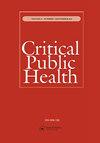地方部门间网络用于创造更健康环境的两项战略:蒙特利尔城市环境的跨案例分析
IF 2.3
3区 医学
Q2 PUBLIC, ENVIRONMENTAL & OCCUPATIONAL HEALTH
引用次数: 0
摘要
旨在发展更健康生活条件的行动需要跨部门和各级政府之间的部门间合作。它还要求市级和更高一级的政治和机构当局作出承诺。本文的重点是植根于民间社会的地方跨部门网络解决生活条件的战略。对蒙特利尔(加拿大)的八个案例研究进行了纵向交叉案例分析。数据来源包括1445份文件和41次访谈。案例研究是根据侧重于关键事件的理论框架和地方部门间网络为产生变革而动员的一系列过渡性成果(TOs)进行分析的。分析的重点是每种情况下TOs的分布。确定了两种策略。Do It战略主要依赖于获取资源以及扩大和加强网络和项目。在这一战略中,网络掌握了关键的决策和行动杠杆,以自己推动项目。相比之下,“实现”策略主要是围绕导致自我表现和影响他人的行为构建的。在这一战略中,网络具有一定的杠杆作用,例如动员其公民和社区基础,但它们也必须说服决策者支持行动。本文描述并比较了这两种类型的局部变化行动策略的主要特征。本文章由计算机程序翻译,如有差异,请以英文原文为准。
Two strategies used by local intersectoral networks to create healthier environments: a cross-case analysis in the Montreal urban setting
Action aimed at developing healthier living conditions requires intersectoral collaboration, both across sectors and between levels of government. It also calls for the commitment of political and institutional authorities at municipal and higher levels. This article focuses on strategies of local intersectoral networks rooted in civil society for addressing living conditions. A longitudinal cross-case analysis was performed on eight case studies in Montreal (Canada). Data sources include 1445 documents and 41 interviews. Case studies were analyzed based on a theoretical framework focusing on critical events and a repertoire of transitional outcomes (TOs) that local intersectoral networks mobilised in order to produce change. The analysis focussed on the distribution of TOs in each case. Two types of strategies were identified. The Do It strategy relied primarily on acquiring resources as well as expanding and strengthening networks and projects. In this strategy, networks held the key decision-making and action levers to drive projects by themselves. In contrast, the Make It Happen strategy was mainly constructed around actions that led to self-representation and influencing others. In this strategy, networks held certain levers – such as mobilizing their citizen and community bases – but they also had to convince decision-makers to support action. This article describes and compares the key features of these two types of action strategies for local change.
求助全文
通过发布文献求助,成功后即可免费获取论文全文。
去求助
来源期刊

Critical Public Health
Multiple-
CiteScore
5.90
自引率
7.10%
发文量
36
期刊介绍:
Critical Public Health (CPH) is a respected peer-review journal for researchers and practitioners working in public health, health promotion and related fields. It brings together international scholarship to provide critical analyses of theory and practice, reviews of literature and explorations of new ways of working. The journal publishes high quality work that is open and critical in perspective and which reports on current research and debates in the field. CPH encourages an interdisciplinary focus and features innovative analyses. It is committed to exploring and debating issues of equity and social justice; in particular, issues of sexism, racism and other forms of oppression.
 求助内容:
求助内容: 应助结果提醒方式:
应助结果提醒方式:


